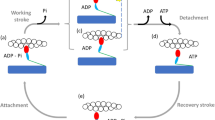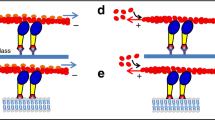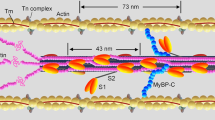Abstract
MOTOR proteins such as myosin, dynein and kinesin use the free energy of ATP hydrolysis to produce force or motion, but despite recent progress1–4 their molecular mechanism is unknown. The best characterized system is the myosin motor which moves actin filaments in muscle5–12. When an active muscle fibre is rapidly shortened the force first decreases, then partially recovers over the next few milliseconds5. This elementary force-generating process is thought to be due to a structural 'working stroke' in the myosin head domain5–9, although structural studies have not provided definitive support for this10–12. X-ray diffraction has shown that shortening steps produce a large decrease in the intensity of the 14.5 nm reflection arising from the axial repeat of the myosin heads along the filaments13,14. This was interpreted as a structural change at the end of the working stroke, but the techniques then available did not allow temporal resolution of the elementary force-generating process itself. Using improved measurement techniques, we show here that myosin heads move by about 10 nm with the same time course as the elementary force-generating process.
This is a preview of subscription content, access via your institution
Access options
Subscribe to this journal
Receive 51 print issues and online access
$199.00 per year
only $3.90 per issue
Buy this article
- Purchase on Springer Link
- Instant access to full article PDF
Prices may be subject to local taxes which are calculated during checkout
Similar content being viewed by others
References
Ishijima, A., Doi, T., Sakurada, K. & Yanagida, T. Nature 352, 301–306 (1991).
Uyeda, T. Q. P., Warrick, H. M., Kron, S. J. & Spudich, J. A. Nature 352, 307–311 (1991).
Schroer, T. A., Steuer, E. R. & Sheetz, M. P. Cell 56, 937–946 (1989).
Block, S. M., Goldstein, L. S. B. & Schnapp, B. J. Nature 348, 348–352 (1990).
Huxley, A. F. & Simmons, R. M. Nature 233, 533–538 (1971).
Reedy, M. K., Holmes, K. C. & Tregear, R. T. Nature 207, 1276–1280 (1965).
Huxley, H. E. Science 164, 1356–1366 (1969).
Lymn, R. W. & Taylor, E. W. Biochemistry 10, 4617–4624 (1971).
Huxley, A. F. Prog. Biophys. biophys. Chem. 7, 255–318 (1957).
Cooke, R. CRC Crit. Rev. Biochem. 21, 53–118 (1986).
Thomas, D. D. A. Rev. Biochem 49, 691–709 (1987).
Irving, M. in Fibrous Protein Structure (eds Squire, J. M. & Vibert, P. J.) 495–528, (Academic, London, 1987).
Huxley, H. E. et al. J. molec. Biol. 169, 469–506 (1983).
Huxley, H. E., Faruqi, A. R., Kress, M., Bordas, J. & Koch, M. H. J. J. molec. Biol. 159, 637–684 (1982).
Ford, L. E., Huxley, A. F. & Simmons, R. M. J. Physiol., Lond. 269, 441–515 (1977).
Ford, L. E., Huxley, A. F. & Simmons, R. M. J. Physiol., Lond. 311, 219–249 (1981).
Lombardi, V., Piazzesi, G. & Linari, M. Nature 355, 638–641 (1992).
Yanagida, T., Arata, T. & Oosawa, F. Nature 316, 366–369 (1985).
Harada, Y., Sakurada, K., Aoki, T., Thomas, D. D. & Yanagida, T. J. molec. Biol. 216, 49–68 (1990).
Uyeda, T. Q. P., Kron, S. J. & Spudich, J. A. J. molec. Biol. 214, 699–710 (1990).
Huxley, H. E. J. biol. Chem. 265, 8347–8350 (1990).
Irving, M. Nature 352, 284–286 (1991).
Kushmerick, M. J. & Davis, R. E. Proc. R. Soc. B174, 315–353 (1969).
Lombardi, V. & Piazzesi, G. J. Physiol., Lond. 431, 141–171 (1990).
Piazzesi, G., Francini, F., Linari, M. & Lombardi, V. J. Physiol., Lond. 445, 659–711 (1992).
Matsubara, I. & Yagi, N. J. Physiol., Lond. 361, 151–163 (1985).
Cecchi, G., Colomo, F. & Lombardi, V. Boll. Soc. ital. Biol. Sper. 52, 733–736 (1976).
Huxley, A. F. & Lombardi, V. J. Physiol., Lond. 305, 15–16P (1981).
Huxley, A. F., Lombardi, V. & Peachey, L. D. J. Physiol., Lond. 317, 12–13P (1981).
Towns-Andrews, E. et al. Rev. sci. Instrum. 60, 2346–2349 (1989).
Author information
Authors and Affiliations
Rights and permissions
About this article
Cite this article
Irving, M., Lombardi, V., Piazzesi, G. et al. Myosin head movements are synchronous with the elementary force-generating process in muscle. Nature 357, 156–158 (1992). https://doi.org/10.1038/357156a0
Received:
Accepted:
Issue Date:
DOI: https://doi.org/10.1038/357156a0
This article is cited by
-
Cross-bridge mechanics estimated from skeletal muscles’ work-loop responses to impacts in legged locomotion
Scientific Reports (2021)
-
Induced Pluripotent Stem Cell–Derived Cardiomyocytes from a Patient with MYL2-R58Q-Mediated Apical Hypertrophic Cardiomyopathy Show Hypertrophy, Myofibrillar Disarray, and Calcium Perturbations
Journal of Cardiovascular Translational Research (2019)
-
Monitoring the myosin crossbridge cycle in contracting muscle: steps towards ‘Muscle—the Movie’
Journal of Muscle Research and Cell Motility (2019)
-
A myosin II nanomachine mimicking the striated muscle
Nature Communications (2018)
-
Coordinated force generation of skeletal myosins in myofilaments through motor coupling
Nature Communications (2017)
Comments
By submitting a comment you agree to abide by our Terms and Community Guidelines. If you find something abusive or that does not comply with our terms or guidelines please flag it as inappropriate.



